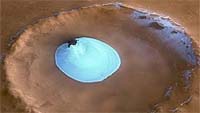Scientists believe they have found photographic evidence of flowing water on Mars
New photographs from space suggest that water occasionally flows on the frigid surface of Mars, raising the tantalizing possibility that the Red Planet is hospitable to life, scientists reported.

The new images, taken by NASA's Mars Global Surveyor before it lost contact with Earth, do not actually show flowing water. Rather, they show changes in craters that provide the strongest evidence yet that water coursed through them as recently as several years ago, and is perhaps doing so even now.
"This is a squirting gun for water on Mars," said Kenneth Edgett, a scientist at San Diego-based Malin Space Science Systems, which operates a camera on the Global Surveyor.
The news excited scientists who hunt for extraterrestrial life. If the finding is confirmed, they say, all the ingredients favorable for life on Mars are in place: liquid water and a stable heat source.
In all of its Mars exploration missions, NASA has pursued a "follow the water" strategy to determine if the planet once contained life or could support it now.
Scientists believe ancient Mars was awash with pools of water. And at present-day Mars' north pole, researchers have spotted evidence of water ice. But they have yet to actually see water in liquid form.
"This underscores the importance of searching for life on Mars, either present or past," said Bruce Jakosky, an astrobiologist at the University of Colorado at Boulder, who had no role in the study. "It's one more reason to think that life could be there."
Some researchers were skeptical that liquid water was responsible for the surface feature changes seen by the spacecraft. They said other materials such as sand or dust can flow like a liquid and produce similar results, reports AP.
"Nothing in the images, no matter how cool they are, proves that the flows were wet, or that they were anything more exciting than avalanches of sand and dust," Allan Treiman, a geologist at the Lunar and Planetary Institute in Houston said in an e-mail.
The findings will appear in Friday's issue of the journal Science.
The Global Surveyor previously spotted tens of thousands of gullies that scientists believed were geologically young and carved by fast-moving water coursing down cliffs and steep crater walls. Scientists decided to retake photos of thousands of gullies in a search for evidence of recent water activity.
Subscribe to Pravda.Ru Telegram channel, Facebook, RSS!




